The really simple guide to making your own garden compost
Making your own garden compost is really easy.
And it’s fabulously good for your garden plants. Professional gardeners call it ‘garden gold.’
Plus it will save you taking garden clippings to the recycling centre.
Finally, it’s very good for the environment as you are recycling material without incurring petrol costs.
But there are some myths about making compost which have built up over the years. Let’s see which are true and which are false.
If you prefer to watch a video, see the top garden compost tips video here.
Garden compost or potting compost?
There’s a bit of confusion over this one. There are two different things called ‘compost’. One is ‘garden compost’ and the other is ‘potting compost’.
Garden compost is rotted down waste. It can be made from garden clippings or raw fruit and vegetable scraps from your kitchen. You can also add paper or cardboard.
Use garden compost to improve your soil. It helps the soil retain water and feeds the micro-organisms and worms which keep soil healthy. Your plants will grow and flower better.
The best way to use garden compost is to lay 2-3″ on your borders once or twice a year. Most plants won’t need fertiliser if you do this.
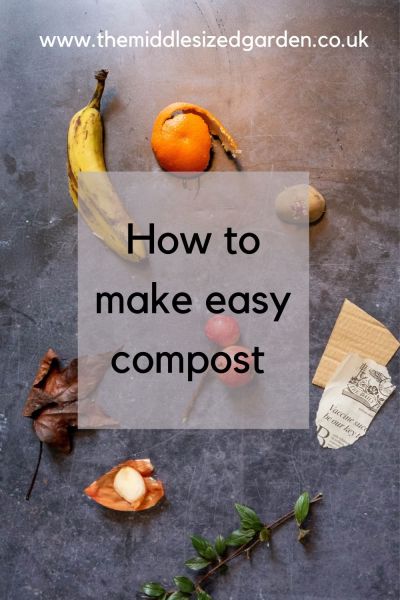
But potting compost is…
Potting compost is a soil-type substance you buy in sacks in the garden centre. It’s been specifically designed to use in pots for container-grown plants or in trays for growing from seed.
Most people don’t make their own potting compost. If you do want to make your own potting compost, The RHS suggests that you can use a two-thirds/one-third mix of garden soil and garden compost for plants in pots.
If you’re buying potting compost, always look for brands marked ‘peat-free’. If it’s not marked ‘peat-free’ it has peat in it, even if it’s labelled ‘organic.’
And if you’re looking for compost to improve your garden soil, ‘potting compost’ from the garden centre isn’t the right product. Buy well rotted manure, mushroom compost or ‘soil improver’ instead.
How to compost garden waste the super-easy way
Buy or make a compost bin. It’s best to have more than one, but if you’ve only got space for one, that’s better than none.
Add approximately equal amounts of green waste and brown waste to the bin. Keep adding it. Even if you think your bin is full, the amount of material reduces as it rots down. You will always be able to fit a bit more in.
Give it a stir or turn it from time to time.
It will rot down over 6-18 months into a brown, soil-like substance. That means it’s ready to use on your borders.
And that’s it. There really is nothing more to making garden compost than that.
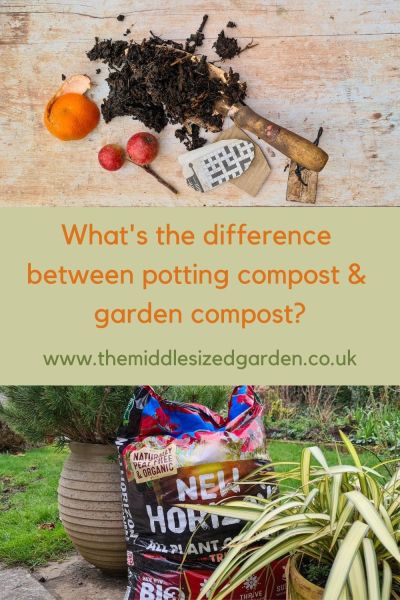
You make garden compost out of kitchen scraps and garden waste. Use it on borders. The sack is potting compost, which I bought for my pots and seedlings.
What is green and brown waste?
Fruit and vegetables scraps, grass clippings, coffee grounds and the green parts of plants are called ‘green waste’.
Cardboard, newspaper, twigs, sticks, straw, dead leaves, wood ash or wood chips all count as ‘brown waste.’
While you need a roughly equal split between them, there’s no need to worry too much. When you prune plants, there’s often a mix of brown (woody stems) and green leaves anyway. In my experience, life produces a mix of green and brown waste without your having to trouble yourself too much about proportions.
If you get too much green, the compost may smell or go slimy. Just add cut up cardboard or newspaper and throw it in.
What is the best compost bin?
You can have wooden compost bins, plastic compost bins or just have a pile of compost in a corner of the garden. Plastic bins will get hotter, which will speed up compost making.
In terms of shape, you can choose from square, bell-shaped and ‘beehive.’
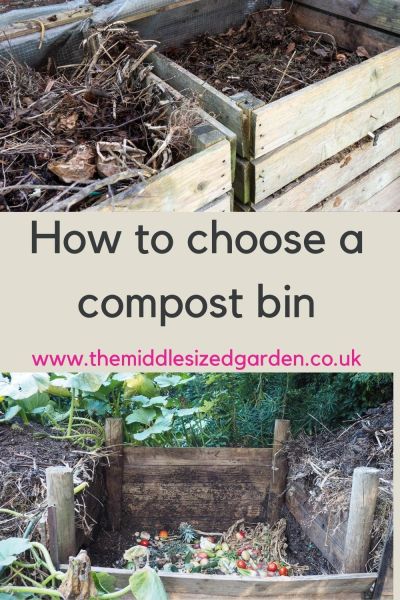
I prefer these square compost bins because they make the most of the vertical space.
Personally, I prefer the square bins because they make the most of the space available.
A ‘pile’ of compost is probably only suitable in a fairly big garden, where there is plenty of space.
The bell shaped compost bins seem only to take a limited amount of waste material. I also find it difficult to ‘turn’ the compost and to get waste in or compost out of the smaller bell shaped bins.
I’ve never tried the beehive bins. Once again, I don’t think they’re best use of space.
What to think about when choosing a compost bin
When you are choosing a compost bin, make sure that you have easy access at the top. You need to be able to throw raw material in without too much fiddling about, so check that the top comes off easily. You also need to cover the raw material so that it doesn’t get too wet in the rain, so you do need a lid. Throw a tarpaulin over it if you have an open pile.
And you need to be able to reach into the compost with a fork or spade to ‘turn’ or stir the compost. It’s less easy to do these things if you have a small top or a lid that is difficult to take off.
You also need to be able to get the compost out easily. Ideally, you will have two or three bins, so that you can leave one pile to rot completely. You can then take the compost out of the whole bin at once or take from the top.
But if you only have space for one bin, you’re expected to take the finished compost out through a removable slat at the bottom. So far I have never found any bottom slat or door which makes this comfortable. And friends agree. Forget about the hatch, slat or small door at the bottom of a compost bin. You will never use it.
I like the look of square plastic bins, although I haven’t tried them. If I was buying new now, I would get an Eco King plastic composter or wooden slatted bins with fronts I could completely remove.
What goes in the garden compost bin?
There are more myths and misunderstandings about this than anything. Most of us were brought up to think that there was one ingredient that you absolutely must NOT add to compost.
But you can add grass clippings and all raw fruit and vegetables or peels. You can add bananas, apples, potatoes, citrus fruits and pumpkins.
Of course, potatoes may sprout, but if they do, just snap off the growing stem and toss it back into the compost.
Recently we’ve been buying food that is delivered in ‘compostable’ cartons. This is a fairly recent development so I don’t know how long they’ll take to compost down. If your compostable bags and cartons don’t rot down at the same rate as the rest of the compost, filter them out and return them to the compost pile.
You can add wood ash, but not coal ash. Wood ash is very good for gardens. Coal ash has chemicals. Don’t put it in your compost or on your borders.
I was told never to add leaves, citrus fruit or grass clippings to compost
My mother used to think that if you added grass clippings to your compost, then you’d get grass growing in your borders when you added the finished compost.
But most grass is cut before it’s had a chance to flower and run to seed. And once the compost has decomposed, then it’s no longer grass. It’s compost. We’ve been adding grass clippings to the compost for years. It’s never created grass in the borders.
Too many grass clippings can make the compost slimy. But just add more torn up newspaper and the problem will be solved.
Some people worry about the acidity of orange or lemon peel in the compost. But you would need an enormous proportion of citrus peels to make a difference. The same goes for pine needles. Garden designer Adam Frost monitored the soil under some pine trees in his garden. Even though the pine needles dropped constantly year in, year out, they didn’t change the acidity of the soil.
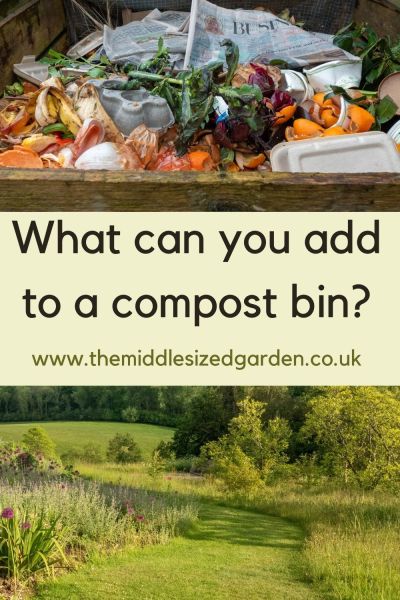
Yes, you can add grass clippings, citrus fruit and newspapers to a garden compost bin.
Autumn leaves may take longer to rot down than other elements in garden compost. However, if you run the mower over them – or just mow the lawn with the leaves on it – then they will be chopped up enough.
Can you compost garden weeds?
This is a little more tricky. If your compost bin is dark and hot, such as a Hotbin, then you can add weeds. They’ll rot down completely.
But if, like mine, your compost bin is a bit higgeldy-piggeldy, light will get in. And it’ll never get hot enough to kill the roots of perennial weeds. The weeds will grow in the compost. They’ll then get returned to the border when you use the compost.
I put weeds in a black dustbin bag and add them to the compost bin when they’ve already rotted down. Or we make a few journeys to the local recycling plant.
Expert gardening writer Sally Nex is the author of How to Garden The Low Carbon Way. The book is an excellent, practical guide to low waste, low cost gardening and I’ll be talking to Sally in more detail in another post. She has a good tip for composting weeds: ‘Pile them all in a bucket, cover them with water and leave them to rot.’ They will rot down in the bucket and should be rotted enough to add to the compost bin in about a month.
Can you add dog, cat or pet waste to garden compost?
It’s generally considered a bad idea. If you do want to compost pet waste, do it separately and only use it on the garden for ornamental plants. And only apply it under trees or somewhere you’re unlikely to weed, not on the vegetable patch. While completely rotted waste isn’t likely to pose a threat, it would be difficult – impossible, even – to ensure that absolutely every particle was rotted down and that no pathogens remain.
If your pets have a disease you could catch, then you are likely to catch it regardless of whether you compost their waste.
But many people do add rabbit or guinea pig waste and bedding to garden compost. That’s because the animals are not meat-eaters. You can also add cow or horse manure to your compost. However, if you have a horse or a cow, that often means quite a lot of manure. Your compost heap will become a manure heap. Which is fine.
Can you add ‘compostable’ and biodegradable packaging to your compost heap?
There’s a great deal of conflicting information out about this issue. However, ‘biodegradable’ as a term isn’t about meeting specific standards. If it says ‘biodegradable’ on the packaging, don’t put it on your compost heap. Essentially, it just means it breaks down but doesn’t give you information on how long that takes or what it breaks down into.
‘Compostable’ means that it has to be able to compost on a compost heap within 12 weeks. Compostable packaging is usually made from sugar or potato starches, not from petroleum based products. It should have a logo to show that it meets these standards, such as the Seedling logo.
There is another category called ‘oxo-degradable plastics.’ These are plastics which break down more quickly than traditional plastic. But when they break down, they create micro plastics, which can be even more of a problem in the soil or the sea. Oxo-degradables are banned in Europe and some other countries, and several environmental organisations have called for them to be banned in the UK too.
All the environmental organisations say that the way to reduce plastic and packaging waste is to abolish single-use packaging rather than to make that packaging biodegradable or compostable. And if you don’t do home composting, not all local recycling services take compostable packaging because it’s contaminated with food waste.
Will compost attract flies?
Some people worry that adding raw fruit and vegetable peelings will attract flies or ants. You may get fruit flies, but if so it’s probably a sign that the compost is too wet, so keep it covered. As for ants, they won’t do any damage. Compost is broken down by micro-organisms, worms and insects, so they are part of the de-composition process.
Does making garden compost take a long time?
This is where you need to know the difference between easy compost and fast compost. Easy compost is as simple as throwing ingredients onto a pile and keeping it covered. But it does take much longer to rot down than fast compost or ‘hot composting.’
Easy compost will take between about six and eighteen months before it’s ready to go on the soil. Fast compost or ‘hot composting’ takes 3-4 months or even faster with some methods.
It’s important to turn or stir your compost and if you do this regularly, it will speed it up. Use a spade to transfer half-rotted compost from one bin to another.
Or you can plunge a garden fork deep into the compost and rotate it as widely as you can. Then remove the fork and repeat in another part of the compost.
The advantages of fast composting
The faster methods of making compost mean you can make more compost. You can also recycle more kitchen scraps and garden clippings. Our lazy, easy-compost ways mean that we still sometimes have to take garden clippings to the recycling centre. Although you can usually create a bit more space by plunging a garden fork deep into the compost and rotating it for a while. If you repeat this several times, the level of compost will drop a few inches.
But fast compost means being meticulous about the proportion of green to brown, turning your compost regularly and a few other things I haven’t got a grip of yet. Try Charles Dowding on compost if you want to be a proper composter.
There is a very fast system called a Hotbin. The bin gets hot enough, and secure enough to compost all food waste, even fish and meat. I haven’t tried it, but friends speak highly of it. It’s generally had good reviews on review sites. Other quick composting systems include wormeries and Bokashi bins.
But the advantage of easy, ‘cold’ composting is that all you do is throw the materials into the bin and occasionally turn it. It’s like having a self-emptying waste paper basket in the corner of your garden, because as it rots down, more space becomes available. You really don’t have to think about it.
All the fast composting systems require a little more attention. Read Composting for Dummies to find out more about fast compost.
Can garden compost be used in pots?
Personally, I prefer to buy tailor made potting compost for pots.
The RHS says that you can make up a compost for plants in pots by using two thirds of garden soil to one third of your home-made compost. Add fertiliser or water-retaining granules.
Sally Nex’s How to Garden the Low Carbon Way also has some recipes for using garden compost for pots or growing from seed.
When to use garden compost?
Add a 1-2″ layer of garden compost to your borders once a year, in either spring or autumn. You don’t need to dig it in. Just leave it there and the worms and micro-organisms will dig it in for you.
It doesn’t make borders higher because it is absorbed over the year. Find out more about no-dig techniques for flower borders here.
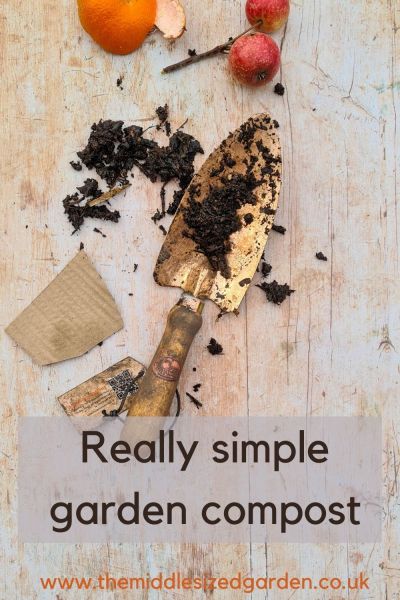
Can you put too much compost on your garden soil?
This is probably something you don’t need to worry too much about. There are studies to show that too much manure or fertilisers leach out of the soil and into the water supply. But there’s no point in worrying about whether you accidentally put 5″ of compost rather than 2″ on a border. You can put less on next time.
After all, your home-made garden compost came from your garden. You’re not adding anything, just returning what came from the soil to the soil.
One of the Middlesized Garden YouTube channel’s most popular videos is How to Make a Flower Border Look Amazing. It features Paul and Frances Moskovits, who use a great deal of compost and manure on one of their borders. Their garden is brilliantly healthy and hums with the sound of bees and birdsong.
However, some gardeners would say that they put on ‘too much’ compost and manure. If you’re buying manufactured compost, fertilisers and manure, there may be added chemicals which can leach out of the soil.
Just follow the instructions on the labels and you will be fine.
Can compost burn plants?
No, your own home-made garden compost won’t burn your plants.
But if you buy manure from a store or a farm, that could burn plants if it isn’t sufficiently rotted. And there is a weed-killer that you may find in some manures. It’s called aminopyralid and it’s used to kill weeds in pasture. If you get manure that is contaminated by aminopyralid, then it may damage some of your plants.
The RHS recommends leaving a pile of aminopyralid-contaminated manure for a few months on an empty border for several months. It will be broken down by soil bacteria.
Do I need fertilizer if I use compost?
When you add a layer of garden compost, well rotted manure or mushroom compost to your borders, it’s called ‘feeding the soil.’
But when you add fertiliser, that’s called ‘feeding the plant.’ Most gardeners say that it’s better to feed the soil than feed the plant.
So if you layer 1-2″ of compost on top of your soil once a year, you’re feeding the soil. You won’t have to feed most of your plants.
However, vegetables grow very fast and need extra. So you will get better yields if you fertilise them as well as mulching. And roses, too, are very hungry plants. You will get significantly better performance if you give them a spring and a mid-summer feed. See more about how to look after roses here.
Not everyone agrees with this. Many expert gardeners do avoid the use of fertilisers by keeping their soil in prime condition. But, as an amateur gardener, I have had better results with vegetables and roses by using it.
Note that compost isn’t fertiliser. You only add fertiliser to a plant in your garden when the plant is growing and can use it. That will only be in spring and/or summer. The chemicals in fertilisers mean the nutrition can be washed away if, for example, you put it on borders in autumn, when plants don’t grow.
But you can add compost in autumn because it doesn’t contain fertiliser that can be washed away.
Shop my favourite garden tools, products and books
I’m often asked for recommendations so I’ve compiled some lists of gardening books, tools and products on the Middlesized Garden Amazon store. Note that links to Amazon are affiliate, so I may get a small fee if you buy but it doesn’t affect the price you pay. But I only recommend things I use myself or which have been recommended by garden sources I trust.
Pin to remember a simple guide to homemade compost
And do join us once a week – see here to get more garden tips, ideas and inspiration straight to your email inbox.
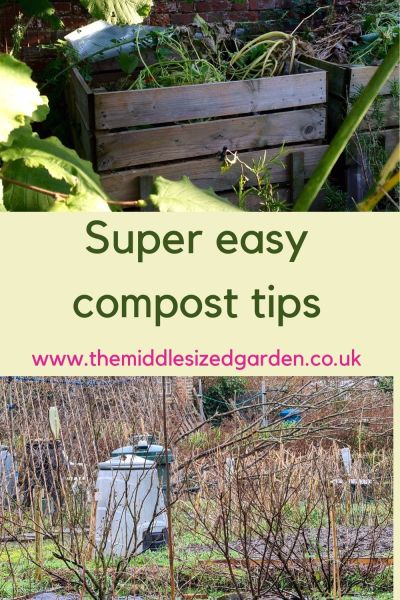
























Composting is so addictive! I managed to get a free plastic compost bin off facebook a few years ago (I love recycling too) and haven’t looked back. I can’t get over how quickly in the summer everything rots down. I definitely find you need to layer consistently, brown, green, brown etc, and not let it get too dry or too wet but you soon get the hang of it. My rhubarb loves it!
Thank you for commenting and good points. There was a problem with your link (it was flagged by my system, so I had to remove it). It might be worth checking it, although it may just be a problem from this end.
I have found that the so-called compostable bags are still intact enough to be unsightly two years later! At first I pulled them all out and threw them away. Now I use paper bags for my food waste – problem solved.
I think they vary hugely, but you’re right that the real solution is to use less plastic packaging rather than to try to make the packaging compostable.
On beehive bins I’d say the only plus for them is how ornamental they are. I have them because my bins are in full sight, for me and for passers by so although not the best for volume, they are an attractive addition to the garden all year around. They make great easy compost too. Such an informative blog on a subject that confuses beginners I think.
Thank you!
I have been given a tumbling plastic compost bin. How often should I tumble it round and will it make quicker compost
It should make quicker compost, yes. Check the manufacturer’s name on the bin and go online to find their operating instructions as bins may differ. If you can’t find a manufacturer’s name on it, then tumble it every 3-4 days.
Very informative piece, thanks! I’d just like to add a word of warning about plunging a fork into the compost heap to turn it: it’s best to check the heap first for the presence of wildlife (especially hedgehogs and grass snakes) to avoid injury to the wildlife.
Good point! Thank you.
Excellent article, full of information and ideas.
Thank you.
Best wishes Phil
Thank you!
I have a very sloping garden! Where the only flat areas suitable for compost binsare subject to flooding, up ti 6 inches, 2 or 3 times every winter. Would this make it impossible for compost?
I think it would be difficult to get good compost in an area that floods easily. Perhaps a compost tumbler would be an idea? These have legs and they are closed drums, so they would be above the flooded area, and they also make very fast compost. I haven’t personally tried one, so I can’t give advice, but I’d suggest having a look on the internet and seeing if there’s one that appeals.